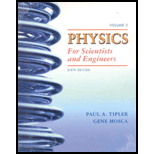
Concept explainers
(a)
The speed of the water.
(a)
Answer to Problem 67P
Explanation of Solution
Given:
Temperature of water is
Flow rate of water is
Diameter of the tap is 1.20 cm
Formula used:
Let us represent the flow rate of the water as
Now we can relate the flow rate of water to the area of cross section of the circular tap
Area of cross section of circular tap interms of its diameter
Substituting for
Calculation:
Substituting the numerical values in equation
Conclusion:
The speed of the water is
(b)
The diameter of the stream at a point
(b)
Answer to Problem 67P
Explanation of Solution
Given:
Temperature of water is
Flow rate of water is
Stream has circular cross section
Neglect any effects of drag forces acting on the water
Formula used:
Let us apply the continuity equation to the stream of water,
Where,
Interms of diameter, cross sectional areas can be written as,
Substituting these in equation
Now correlate
Calculation:
Substituting the numerical values in equation
Substituting the numerical values in equation
Conclusion:
The diameter of the stream at a point
(c)
The distance does the water have to fall before it becomes to turbulent and to see whether this match our everyday observations.
(c)
Answer to Problem 67P
Explanation of Solution
Given:
Temperature of water is
Flow rate of water is
Reynolds number
Formula used:
Correlating the fall-distance to-turbulence
Express Reynolds number
Where
The volume flow rate equals to
Eliminating
Calculation:
Substituting the numerical values in equation
Substituting the numerical values in equation
This value is in reasonable agreement with everyday life.
Conclusion:
The distance does the water have to fall before it becomes to turbulent is
This value is in reasonable agreement with everyday life.
Want to see more full solutions like this?
Chapter 13 Solutions
Physics for Scientists and Engineers, Vol. 3
- Fluid originally flows through a tube at a rate of 100 cm3/s. To illustrate the sensitivity of flow rate to various factors, calculate be new flow rate for following changes with all other factors remaining the same as in original conditions. (a) Pressure difference increases by a factor of 1.50. (b) A new fluid wit 3.00 times greater viscosity is substituted. (c) The tube is replaced by one having 4.00 times the length. (d) Another tube used with a 0.100 times the original. (e) Yet another tube is substituted with a radius 0.100 times the original and half length, and pressure difference is increased by factor of 1.50.arrow_forwardWater emerges straight down from a faucet with a 1.80-cm diameter at a speed of 0.500 m/s. (Because of the construction of the faucet, there is no variation in speed across the stream.) (a) What is flow rate in cm3/s? (b) What is the diameter of the stream 0.200 m below the faucet? Neglect any effects due to surface tension.arrow_forwardWater is moving at a velocity of 2.00 m/s through a hose with internal diameter of 1.60 cm. (a) What is the flow rate in liters per second? (b) The fluid velocity in this hose's nozzle is 15.0 m/s. What is the nozzle's inside diameter?arrow_forward
- What is the average flow rate in cm3/s of gasoline to the engine of a car traveling at 100 km/h if it averages 10.0 km/L?arrow_forwardWater enters a smooth, horizontal tube with a speed of 2.0 m/s and emerges out of the tube with a speed of 8.0 m/s. Each end of the tube has a different cross-sectional radius. Find the ratio of the entrance radius to the exit radius.arrow_forwardIn an immersion measurement of a woman's density, she is found to have a mass of 62.0 kg in air an apparent mass of 0.0850 kg completely submerged with lungs empty. (a) What of water does she displace? (b) What is her volume? (c) Calculate her density. (d) If her lung capacity is 1.7S L, is she able to that without treading water with her lungs filled air?arrow_forward
- Review. The tank in Figure P15.13 is filled with water of depth d = 2.00 m. At the bottom of one sidewall is a rectangular hatch of height h = 1.00 m and width w = 2.00 m that is hinged at the top of the hatch. (a) Determine the magnitude of the force the water exerts on the hatch. (b) Find the magnitude of the torque exerted by the water about the hinges.arrow_forwardThe left ventricle of a resting adult's heart pumps blood at a flow rate of 83.0 cm3/s , increasing its pressure by 110 mm Hg, its speed from zero to 30.0 cm/s, and its height by 5.00 cm. (All cumbers are averaged over the entire heartbeat) Calculate the total power output of left ventricle. Note that most of the power is used to increase blood pressure.arrow_forwardA small artery has a length of 1.1103m and a radius of 2.55105m . If the pressure drop across the artery is 1.3 kPa, what is the flow rate through artery? (Assume Eat the temperature 37°C)arrow_forward
- Is there a limit to the height to which an entrainment device can raise a fluid? Explain your answer.arrow_forwardWhy is it difficult to swim under water in the Great Salt Lake?arrow_forwardWhat fraction of ice is submerged when it floats in freshwater, given the density of water 0°C is very close to 1000 kg/m3?arrow_forward
 Principles of Physics: A Calculus-Based TextPhysicsISBN:9781133104261Author:Raymond A. Serway, John W. JewettPublisher:Cengage Learning
Principles of Physics: A Calculus-Based TextPhysicsISBN:9781133104261Author:Raymond A. Serway, John W. JewettPublisher:Cengage Learning University Physics Volume 1PhysicsISBN:9781938168277Author:William Moebs, Samuel J. Ling, Jeff SannyPublisher:OpenStax - Rice University
University Physics Volume 1PhysicsISBN:9781938168277Author:William Moebs, Samuel J. Ling, Jeff SannyPublisher:OpenStax - Rice University Physics for Scientists and Engineers, Technology ...PhysicsISBN:9781305116399Author:Raymond A. Serway, John W. JewettPublisher:Cengage Learning
Physics for Scientists and Engineers, Technology ...PhysicsISBN:9781305116399Author:Raymond A. Serway, John W. JewettPublisher:Cengage Learning Physics for Scientists and Engineers: Foundations...PhysicsISBN:9781133939146Author:Katz, Debora M.Publisher:Cengage Learning
Physics for Scientists and Engineers: Foundations...PhysicsISBN:9781133939146Author:Katz, Debora M.Publisher:Cengage Learning College PhysicsPhysicsISBN:9781938168000Author:Paul Peter Urone, Roger HinrichsPublisher:OpenStax College
College PhysicsPhysicsISBN:9781938168000Author:Paul Peter Urone, Roger HinrichsPublisher:OpenStax College




